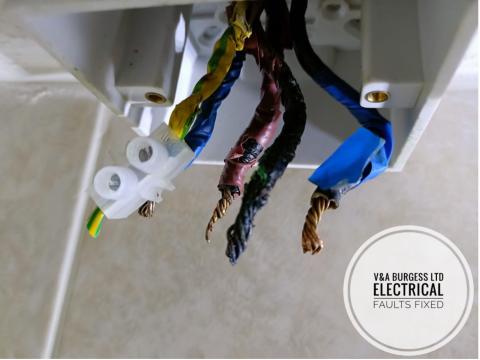
1) When you have an electrical fault in your home then you need an electrical fault-finding specialist to come and investigate the problem for you.
An electrician will have specialist electrical test equipment and the knowledge of how to use it and interpret the results.
When a circuit goes faulty there are traces of the issue that we can pick up with our test equipment and then we can begin to split the circuit into pieces in order to find the location of the fault more accurately. An electrician will measure resistances on a circuit to determine if it is healthy or not.
Back to top2) Trip switch problems?🚩
Your electrician will be able to assist with trip switch problems in your home. A trip switch does not simply trip for no reason. There can be many reasons why a trip switch will keep turning off and an emergency electrician will normally be well used to finding out why.
Not all trip switches are the same and each trip switch will trip for a different reason. A circuit breaker will trip if there are too many electrical items connected and in use. It may take some time to do this as the trip switch has some leeway built in. If there is a short circuit problem in the house then the trip switch will trip off much quicker than simply monitoring a gradual and prolonged excess off appliance use.
The RCD trip switch is different again and will trip when it senses there is some electrical current missing from the circuit which it protects. This device is basically an electric shock protection device and is designed to save lives. It also ruins fridges and freezers when it will not turn back on ☹ Faults involving these trip switch devices should be investigate quickly before the trip switches fail completely and problems grow.
Back to top3) Loose wiring⚠️
Electricians can check for loose wiring by measurement on occasion. By checking the electrical resistance of each of the three conductors and comparing them an electrician can determine if there are possible loose connections on an electrical circuit.
Loose wires can cause fires and we regularly see burnt out sockets, burnt light switches, burnt shower switches and cooker switches. These could have been avoided if connections had been checked by a professional.
An electrician can check for loose connections inside a consumer unit as well. Each consumer unit manufacturer will have a recommended ‘tightness’ or Torque for their internal connections. Your electrician can check what these are and using a specialist torque screwdriver, they can ensure that the connections inside the consumer unit are adequately tight.
Back to top4) Popping or Crackling⚠️
When these kinds of noises appear in an electrical system it is time to turn the electrics off, quickly!
These kinds of noises indicate that there are serious electrical issues that should be investigated by a professional immediately. If left, this type of problem can easily lead to cable damage, electrical failure, or fire! ☹
The popping noise tends to be large fault currents flowing to a low resistance path such as the Line conductor of a circuit touching the Earth path. When this happens there is a very low electrical resistance to electrical current flow and as such a large electrical current will flow (hopefully briefly). This large electrical current can damage or set fire to cabling and this is one of the reasons there are circuit breakers in your electrical box.
Crackling noises are usually indicative or electrical arcing where a current jumps a tiny air gap. The noise created as the current breaks down the resistance of air is a crackling noise. This electrical arcing can generate extremely high temperatures which can lead to fire.
Back to top5) Intermittent power cuts⚠️
Intermittent power cuts can be caused by a fault in the electrical supply from the street into your home. If this is the case then calling 105 will put you through to your local electricity network provider. They will let you know if there are issues in the street or the neighbourhood. The people on the end of the call should be able to give you a rough estimation of when the issue will be fixed, what the issue was and how likely you are to be disturbed with the same issue again.
If there is no issue that they are aware of in the street or with your supply then you need to call and emergency electrician to attend your property as soon as possible. Intermittent power cuts can be indicative of serious electrical issues. Electricians can test for faulty wiring issues in your home such as intermittent power cuts by using their specialist test equipment.
Back to top6) Hidden Faults⚠️
Did you know that there can be hidden electrical faults in your home that will not show unless an electrical inspection is carried out?
Reverse Polarity, Earthing problems, Broken Circuits and more can go completely unnoticed by homeowners as electrical installation appear to function normally. These situations can be deadly if left unfixed and the only way to detect such electrical faults is to have a thorough electrical inspection carried out by a trusted and competent electrician.
A thorough electrical inspection typically costs a few hundred pounds and takes a few hours. This of course depends upon the size of the property and the number of electrical circuits that there are.
6.1) How do electricians find faulty wiring such as hidden faults mentioned above?
Well, they use their knowledge and testing ability when inspecting your electrical installation to determine if everything is safe or not. 😊
For more information on electrical inspections please check out our web-page relating to this:
https://www.electricalfaultsfixed.co.uk/electrical-safety-checks-eicr
If you have any questions then we are always happy to help.
6.2) About
Paul is our Qualified Supervisor and not only specialises in fault finding and electrical inspection but also teaches testing, inspection and wiring regulations to electricians and electrical students.
6.3) Our contact info:
📧 Fill in our contact form here.
Back to top









